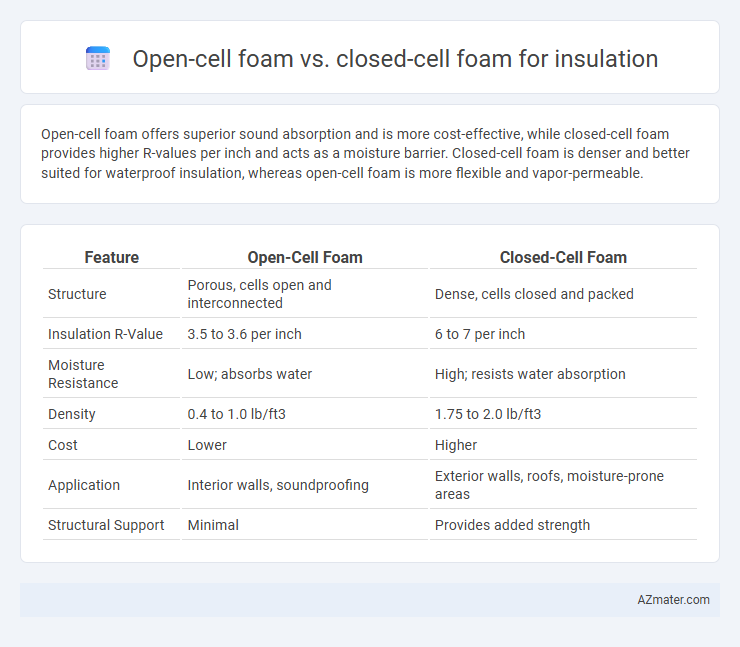Open-cell foam offers superior sound absorption and is more cost-effective, while closed-cell foam provides higher R-values per inch and acts as a moisture barrier. Closed-cell foam is denser and better suited for waterproof insulation, whereas open-cell foam is more flexible and vapor-permeable.
Table of Comparison
| Feature | Open-Cell Foam | Closed-Cell Foam |
|---|---|---|
| Structure | Porous, cells open and interconnected | Dense, cells closed and packed |
| Insulation R-Value | 3.5 to 3.6 per inch | 6 to 7 per inch |
| Moisture Resistance | Low; absorbs water | High; resists water absorption |
| Density | 0.4 to 1.0 lb/ft3 | 1.75 to 2.0 lb/ft3 |
| Cost | Lower | Higher |
| Application | Interior walls, soundproofing | Exterior walls, roofs, moisture-prone areas |
| Structural Support | Minimal | Provides added strength |
Introduction to Foam Insulation
Open-cell foam insulation features a porous structure with interconnected cells, providing excellent air sealing and sound absorption while being lightweight and flexible. Closed-cell foam insulation consists of dense, tightly packed cells filled with gas, offering superior thermal resistance, moisture barrier properties, and structural reinforcement. Choosing between open-cell and closed-cell foam depends on specific insulation needs, climate considerations, and budget constraints.
What is Open-Cell Foam Insulation?
Open-cell foam insulation is a flexible, low-density material characterized by its porous structure, which allows air to fill the open cells, enhancing sound absorption and breathability. It typically has an R-value ranging from 3.5 to 3.6 per inch, making it effective for interior walls and areas where moisture control is less critical. Its ability to expand significantly upon application provides excellent coverage, sealing gaps and cracks to improve energy efficiency while remaining vapor permeable.
Understanding Closed-Cell Foam Insulation
Closed-cell foam insulation features a dense structure with cells that are completely sealed, providing superior moisture resistance and higher R-values per inch than open-cell foam. Its rigid composition offers enhanced structural support and acts as a robust air and vapor barrier, making it ideal for exterior walls and roofing applications. While typically more expensive, closed-cell foam delivers long-term energy efficiency and durability in environments prone to water exposure and extreme temperatures.
Thermal Performance: Open-Cell vs Closed-Cell Foam
Closed-cell foam exhibits superior thermal performance with a higher R-value per inch, typically around 6 to 7, compared to open-cell foam's R-value of approximately 3.5 to 4 per inch. The dense structure of closed-cell foam acts as a more effective air and moisture barrier, enhancing insulation efficiency and reducing heat transfer. Open-cell foam, although less dense and more permeable, provides adequate insulation in interior applications where vapor permeability and sound absorption are advantageous.
Moisture Resistance and Vapor Barrier Capabilities
Closed-cell foam offers superior moisture resistance and acts as an effective vapor barrier due to its dense, impermeable structure that prevents water absorption and vapor transmission. Open-cell foam, with its porous, sponge-like composition, allows moisture to pass through more easily and does not provide a reliable vapor barrier. For insulation applications requiring high moisture resistance and vapor barrier performance, closed-cell foam is the preferred choice.
Soundproofing Qualities Compared
Open-cell foam features an open, porous structure that absorbs sound waves effectively, making it ideal for reducing airborne noise and improving soundproofing within walls, floors, and ceilings. Closed-cell foam has a denser, rigid structure that provides less sound absorption but offers superior sound blocking by creating an airtight barrier that prevents sound transmission. Choosing between open-cell and closed-cell foam depends on whether the priority is sound absorption for echo reduction or sound blocking for noise isolation in insulation projects.
Structural Strength and Durability
Closed-cell foam offers significantly higher structural strength and durability compared to open-cell foam, making it ideal for load-bearing insulation applications. Its dense, rigid composition provides superior resistance to water absorption and compression, enhancing long-term performance in harsh environments. Open-cell foam, while offering excellent breathability and sound insulation, lacks the structural integrity and moisture resistance found in closed-cell variants.
Installation Process and Application Areas
Open-cell foam offers easier installation due to its lightweight and flexible nature, making it ideal for irregular surfaces and tight spaces such as interior walls and attics. Closed-cell foam, being denser and rigid, requires more precise application often using specialized equipment, suitable for exterior walls, roofs, and below-grade insulation where moisture resistance and structural support are critical. Both foams provide thermal insulation, but installation complexity and ideal applications vary based on their material properties and environmental exposure.
Cost Comparison and Budget Considerations
Open-cell foam typically costs between $0.44 and $0.65 per board foot, making it more budget-friendly compared to closed-cell foam, which ranges from $1.00 to $1.50 per board foot. While open-cell foam offers lower upfront costs and effective soundproofing, closed-cell foam provides higher R-values (around 6 to 7 per inch) and better moisture resistance, justifying its higher price for projects requiring superior insulation and durability. Budget considerations should weigh initial expenses against long-term energy savings and specific performance needs of the insulation project.
Which Foam Insulation is Right for Your Project?
Open-cell foam offers excellent sound absorption and breathability, making it ideal for interior walls and areas requiring moisture control, while closed-cell foam provides superior thermal resistance and structural strength, suitable for exterior walls and roofs exposed to harsh weather. Consider project-specific factors such as climate, space constraints, and budget, since closed-cell foam generally costs more but offers higher R-values per inch and moisture barrier properties. Choosing the right insulation depends on balancing energy efficiency goals, moisture protection needs, and overall durability requirements.

Infographic: Open-cell foam vs Closed-cell foam for Insulation
 azmater.com
azmater.com